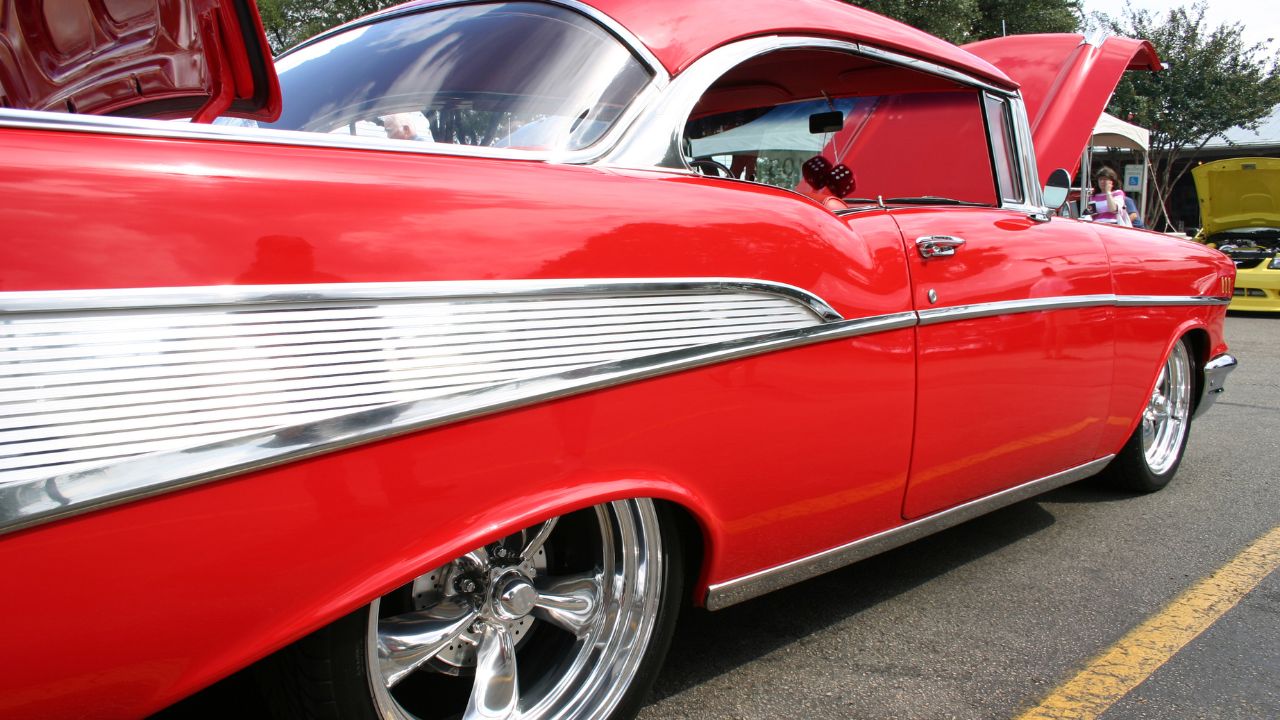
Larry was struck by the 1969 Ford Cobra's uniqueness when he first saw them. The car was in exceptional condition and still had the original Raven Black paint. It was in need of a new paint job, but otherwise, the car was a great deal more original than Larry thought. The Cobra was a Wisconsin native and had not been driven since its new purchase. The car's original owner had taken care of it, and Larry's plan to bring it to the next level was simple.
1969 Ford Cobra
This 1969 Ford Cobra is an investment grade, reference quality muscle car. It is the perfect addition to any collection. It's available for sale now from National Muscle Cars. The car comes in three different configurations: base, R and RS. For this configuration, the engine must be removed and the transmission & transaxle installed in the front.
This is the most powerful Ford car of 1969. The Cobra four-speed transmission produces 335 horsepower. The car comes with competition suspension. Motor Trend tested the Cobra four-speed and said it completed the quarter-mile in 14.5 seconds. Ram Air, which is part of the Cobra's Ram Air system, kept the driver stable and didn't cause motion sickness. The suspension can turn hard corners but it can also be very hairy.

1993 Ford Mustang SVT Cobra
This 1993 Ford Mustang SVT Cobra is a limited-production version of the Fox body sports car. It was equipped with the 5.0-liter V8 engine which is tuned for increased power. The car's original rating was 235 horsepower with 280 lb-ft of torque. SVT tuning used Mustang GT performance as the base for their tuning. The car's cylinder heads were therefore replaced with GT40 pieces. Other modifications to the engine were a modified intake and camshafts. It also featured vented disc brakes.
The engine was powered by a 302CI V8 engine that produced 235 horsepower. It was fitted with GT-40 "High Flow" Cast Iron heads with larger valves and intake port designs. These were fitted with GT-40 lower intake manifolds, and a special tubular aluminum upper intake that was modeled after the GT-40. The GT-40 manifold was designed to divert air into several rectangular ports. H.O. was also bigger than the Mustang Cobra's throttle bodies. spec engines.
1999-2004 Ford Mustang SVT Cobra
SVT offered a convertible performance Ford Mustang SVT Cobra from 1999 to 2004. It used the same V6 engine, but was modified to improve its handling and performance. Cobra received an aluminum flywheel along with the V6 engine. It also featured a revised suspension with individual damping rates. The suspension system included forged alloy wheels and 245/45ZR-17 BFGoodrich CompT/A tires. Its distinctive sound playback began as a low growl at moderate cornering speeds and grew into a penetrating howl at the limit of the car's performance.
SVT engineers were able to remove 50 pounds of weight from the car's front end. Twenty percent of the car's weight was due to the engine. Six pounds were taken from the coil-on-plug, direct ignition system. The new Mustang SVT Cobra's 55/45 fore/aft ratio is about one foot smaller than the predecessor. The new SVT Cobra now weighs 110 lbs less than the old model.

2010 Ford Mustang Cobra Jet
Ford Mustang Cobra Jet, a supercar with high performance that debuted in 2008, is the Ford Mustang Cobra Jet. This supercar has been upgraded to achieve its fourth-generation performance. Cobra Jet 2010 features a new fuel-system that uses a return type system in the trunk. The aluminum intercooler coolant tanks have been replaced. They are more robust and can withstand pressure better. The supercar has fans and a linelock, which disables the rear brakes if there is a fire.
The 2010 Cobra Jet started out as a white Mustang. Watson Engineering, a specialist in performance cars, then installed a cage. It also receives a NHRA-legal rear seats delete panel, firewall, transmission access panels, and a firewall. The Cobra Jet logo and performance name are given to the vehicle after it is returned to AAI. The Cobra Jet's engine and suspension is modified to give it a much higher horsepower than its V6 counterpart.
FAQ
Is being a mechanic apprentice hard?
Although it's not an easy task, you will learn quickly and have many opportunities to advance.
You will need to be patient and persevering. You must also know how to fix cars, trucks, and motorcycles.
Customers and relatives can exert a lot on you. However, you shouldn't be forced to make difficult decisions.
If you like fixing cars, this could be a great career option. This is a job that allows you to earn a decent income and grow your business.
But you may prefer another path. You might consider becoming a technician in this instance.
This could involve using your technical knowledge to support other employees. You could help technicians troubleshoot problems or teach them new techniques.
You can also become a service advisor. Here, you'll provide advice and assistance to customers when they bring their cars to a garage.
It all depends on your goals. There are many options and you have the ability to choose the one that is right for you.
Is it worthwhile to become a mechanic?
This question is dependent on your life goals. If you are looking to make money, then yes. But if meaning and purpose is what you seek, then no.
If you don’t possess any mechanics skills, you won’t be able to do it. It won't make you wealthy. It will not make you famous. It is unlikely that your life will change.
You'd have to spend years learning how things work. It would be expensive to have your car fixed by someone else. This is why most people don’t bother. They find something more worthwhile.
Summarising, if your goal is to make lots of money, go for it. You can't live a meaningful existence if your goal is to make a living in the mechanic's business.
How do I prepare for a mechanic apprenticeship?
It is important that you understand the ramifications of your actions. You need to understand the mechanics of cars and how they work. This will allow you to be prepared for your first day at work.
You should also know how to fix common problems such as tires or broken lights.
These lessons will help you to identify and fix problems.
It is also important to know how the different pieces fit together in order to put them together again.
Finally, you should be able use tools safely.
These things will enable you to be a competent mechanic.
Does it matter where I go to college?
It's not true. In terms of getting into the auto industry, there is no distinction between colleges. However, some schools offer better programs than others so if you're looking for something more specialized, look elsewhere.
How long does it take you to become a great mechanic?
It takes years of practice and experience to become an expert mechanic. Working under the guidance of a professional mechanic is the best way to learn how repair cars.
You will have to spend time in a garage learning about cars and mechanics. Mechanical engineering books will be required to learn about mechanics and design.
Auto school is also required.
The most important thing is to start early. Don't wait until you're older to begin studying automotive technology. Get started now if you are interested in becoming a mechanic.
Statistics
- 52% of Mechanics in the United States think their salaries are enough for the cost of living in their area. (indeed.com)
- According to the BLS, the median annual salary for automotive service technicians and mechanics in the United States was $44,050 in May 2020. (uti.edu)
- Apprentice mechanics earn significantly less hourly than mechanics who have completed training, with a median wage of approximately $14.50 an hour, according to PayScale. (jobhero.com)
External Links
How To
How to properly diagnose and repair your vehicle
The symptoms of your vehicle are the first thing you need to look at in order to determine whether it is in dire need of repairs. Next, you can follow these steps in order to diagnose your car.
-
Check engine lights. You should inspect the dashboard lights, such as the engine light indicator and the oil pressure gauge. Also, check the battery light indicator. It could indicate that your vehicle is having problems.
-
Check the treads of your tires. Tires can become worn and cause problems in handling and braking. It is also important to inspect the wheel treads. They should look clean and be smooth. The best way to do this is to remove the wheels and take them off. Use a flashlight to see how well the treads are worn.
-
Pay attention to the level of your brake fluid. It is important to keep track of how much brake fluid you have in your car. This ensures that your brakes work properly. Your brakes may fail if the brake fluid level drops.
-
Test the suspension system. A suspension system is designed to absorb vibrations and shocks. It improves control and allows for smoother accelerations or decelerations. If your vehicle has a suspension problem, it might feel wobbly or shake uncontrollably. If you are unsure if your vehicle is suffering from a suspension problem, put weight on the front and rear axles to check the movement.
-
Examine the steering wheel. The steering column is used to link the steering wheel with the rest of vehicle's components. Accidents often damage steering columns. If yours feels loose or shaky, you should replace it.
-
Pay close attention to the exhaust tube. The exhaust pipes transport gases from the combustion chamber to outside. If your exhaust pipe leaks or cracks, it will allow harmful fumes into your cabin. Also, if your tailpipe is bent, you should fix it immediately.
-
Look under your hood. To check for unusualities, look under the hood. You could have fluids leaking from the engine. A professional technician should be contacted if your engine compartment emits an unusual smell.
-
Make sure to check the air filter. Your vehicle's air filter collects dust and debris from the outside environment. A dirty filter can lead to a poor vehicle's performance. Replace your air filter regularly.
-
Check the fan belt. Your vehicle's fanbel connects the engine and transmission. If it breaks, the engine won't turn over. Replacing the belt is simple. You will need a screwdriver, pliers and a pair of pliers.
-
Make sure you inspect the radiator hoses and hoses. The radiator-hose carries water to the engine. It can become cracked or damaged and leak hot liquid onto your engine. To repair the leaky hose, all you need is a pair if needle-nosepliers.
-
You should inspect the windshield wipers. Windshield wipers use electricity to remove snow and rain. If they stop working, they could leave streaks on your window glass. Change the washer fluid to fix the problem.
-
You should inspect the cables. Your car's electrical system is powered by batteries. Make sure you disconnect the negative cable before replacing batteries. Failure to do so can damage your alternator.
-
Make sure your headlights are working properly. The headlights will illuminate the road ahead. Bad visibility can be caused by headlights that don't work correctly. Check the bulbs to see if they've burned out.
-
Make sure you have your lights on. When you approach them at night, the lights warn other drivers. One that doesn't work could cause you to be distracted, and possibly lead to an injury.
-
You should inspect your brakes. Before you get in a car accident, your brakes will be slowing down your vehicle. If they aren't working correctly, you could lose control of your car and crash.
-
Make sure to change the oil. Keep your engine lubricated with oil. It protects metal parts and prevents them from wearing too quickly. It is recommended that the oil be changed every other month.